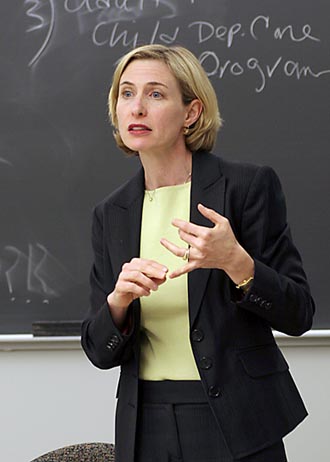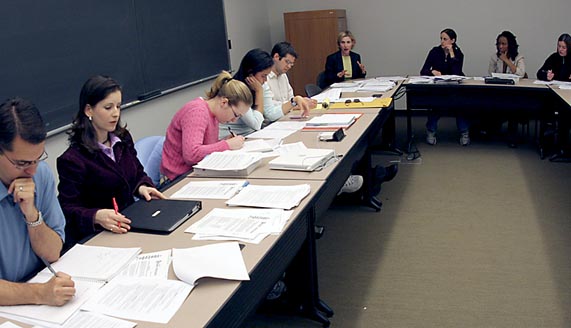

Contents
Students gain insight on children’s policy issues
By Jennifer Greenstein Altmann

Elisabeth Donahue, associate editor of “The Future of Children,” leads a graduate seminar (below) that focuses on childhood obesity, the topic for the spring 2006 issue of the journal.
Princeton NJ -- Students got a rare opportunity to read and critique academic papers before they are published to learn about the process of formulating and refining an academic argument in a spring seminar in the Woodrow Wilson School of Public and International Affairs.
“They are getting the first crack at these papers,” said Elisabeth Donahue, who taught the course, titled “A ‘Future of Children’ Journal Seminar.” Donahue is associate editor of “The Future of Children” journal, which starting this year is being produced by the Wilson School in partnership with the Brookings Institution. It is one of the nation’s leading publications on children’s policy.
Eight graduate students in the master’s degree program in public affairs took the six-week seminar, which focused on the subject of the journal’s next issue: childhood obesity.
The students looked at the causes and consequences of the rise in childhood obesity, as well as examined the different policy areas that relate to the issue — education, parenting, urban planning, and community and industry regulation — to seek solutions. They read the papers submitted to the journal and offered critiques of them in class presentations.
Dave Grande signed up for the class because, as a physician, he has cared for many patients with advanced diabetes, which people who are obese have an increased risk of getting. Grande just completed his residency in internal medicine and is hoping to work on the academic side of medicine, either in research or in public health.
“Helping people who are obese is very difficult,” Grande said. “It makes sense to think about prevention in childhood.”
Danielle Osler, who is earning advanced degrees from the Wilson School and Harvard Law School, said she finds the subject of childhood obesity particularly compelling because “we’ve all been children, we’ve all been in school, so we have a better sense of the issue than other social issues.” Osler, who is planning to work on crafting domestic legislation after graduating, said that the students’ grasp of the issue “will help us see solutions more clearly.”
The students learned how to examine a wide spectrum of academic research on a subject and distill the findings into a brief but comprehensive essay.
“These students want to work in advocacy organizations or in state or federal government, and in those positions you don’t have the luxury of writing 25-page papers,” said Donahue, who also is a lecturer in the Wilson School. “The students are learning how to boil down information into a concise memo.”
They also evaluated whether the articles were easy to understand. The journal’s objective is to provide timely and well-researched information on children’s issues to policy-makers, service providers and the media with the goal of influencing policy decisions. The primary audience is policy-makers, not academics, so the papers are to be written in a style that is accessible to practitioners.
“The students have to think through whether these chapters are meeting the dual goals of being the best social science research and at the same time being accessible to a wide audience,” Donahue said. The final paper in the class was an in-depth critique of two of the papers submitted to the journal.
“The teaching component of the journal is truly an example of a social science laboratory at work,” said Sara McLanahan, professor of sociology and public affairs and editor-in-chief of the journal. “These courses are the perfect way to teach MPA students how to translate research into information that is useful to policy-makers.”
During a recent class, students Kristin Wikelius and Jim Wills offered an analysis of the strengths and weaknesses of one paper for the journal on the role of schools and child care in obesity prevention.
Wikelius discussed an example from the article that cited a worker at a child care center who misunderstood the definition of 100 percent juice.
“One issue that could be addressed a little bit more in the paper is the fact that the people who are in charge of feeding kids and preparing food in the centers might not fully understand the guidelines in place,” Wikelius pointed out. “The article mentioned in passing that people are trained, but from what little evidence we have, it seems that training hasn’t been very effective.”
The article also discussed the fact that schools have been reducing the amount of time allotted for physical education and activity. Wills said the discussion of that issue could have addressed a possible reason why this has happened: Schools are using that time for more academic instruction because of the increased emphasis on testing.
“I think the authors could have given a bit of insight into the competing incentives that go on within the school to focus efforts on the disciplines that are measured,” Wills said. “If the school carves out 15 minutes of recess here or P.E. there, is it so students will perform better on exams?”
After spending five weeks evaluating the papers for the journal, the students attended a two-day rough draft authors’ conference in late April that brought together the authors of the papers, the editors of the journal and outside experts who offered critiques. Although the class critiques of the articles were not included in these sessions, the students were invited to listen to the discussions and ask questions and offer their opinions.
Wikelius, who worked for California Congresswoman Lynn Woolsey before enrolling in the master’s degree program, said she was interested in seeing “academics interact off the record with each other.”
“It’s a great opportunity to actively participate in the conference, especially on an issue like this, where the research is still coming in,” said Alycia Infante, who hopes to work on health policy for the federal government or a nonprofit agency after graduating. “What happens at the conference could influence future policy on obesity.”
Last semester Donahue taught the first “Future of Children” seminar, which was on marriage and child well-being. Students in that class found attending the authors’ conference eye-opening.
“It was particularly interesting to see the different approaches that various authors used in their own work and in critiquing the work of other authors,” said student Jessica Goldberg. “The authors were challenged by each other to think outside of the box, and to remember that questions of child well-being are multifaceted, so research questions must be framed to capture many different causal channels and possible outcomes.”
“The conference was a good chance to make connections with some of the researchers and practitioners involved in the publication,” said Elaine Farber, a student in the class. And being at the conference demonstrated to the students how adept they had become at evaluating the experts: “Some of the debates we listened to were the same ones we had in class!”
The next issue of “The Future of Children,” focusing on marriage and child well-being, is scheduled to be published in fall 2005. The issue on childhood obesity is slated for spring 2006. For more information on the journal, visit <www.futureofchildren.org>.
top


